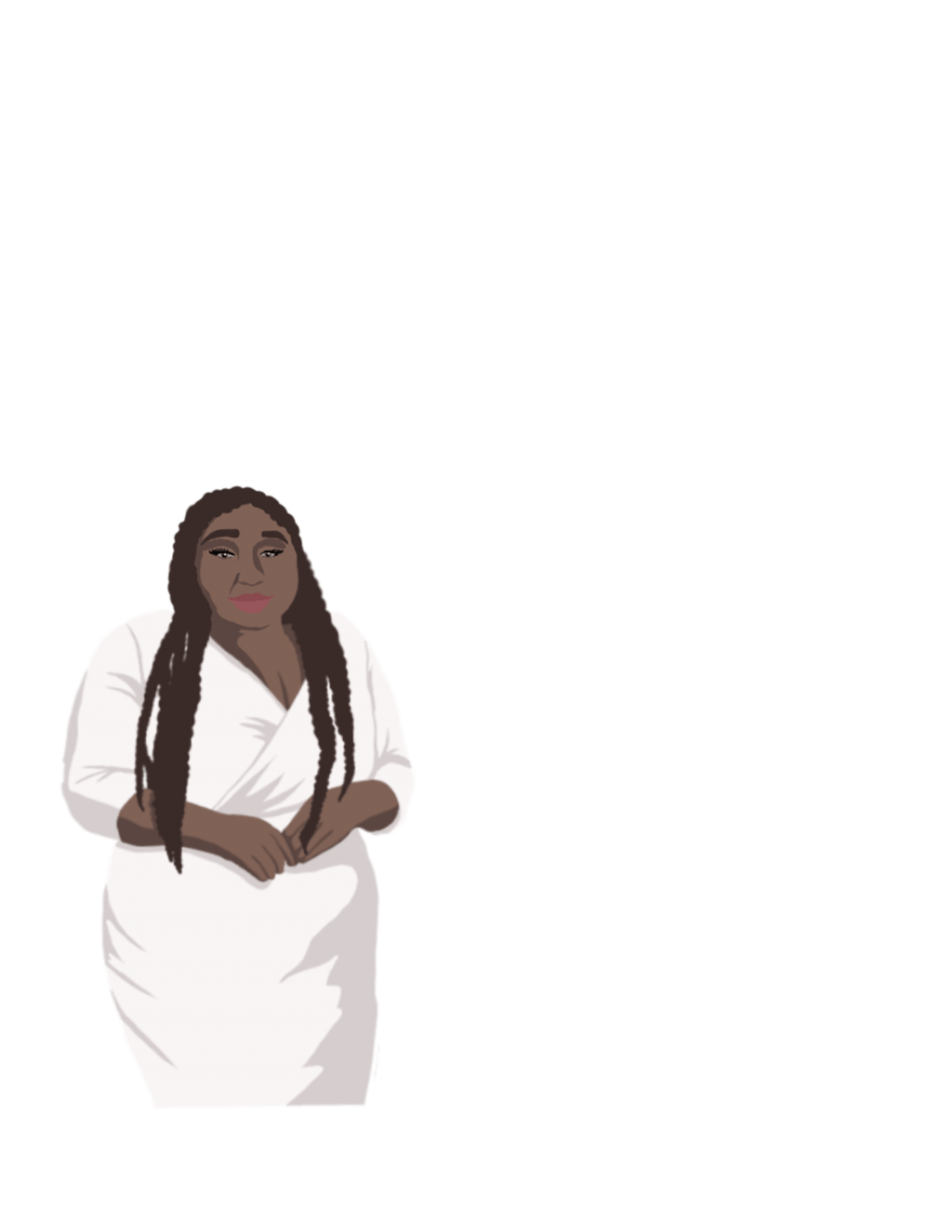Special reporting by Brianna Willis and Maria Belen Iturralde
Art by Caitlin Roark
She was the only African American in her high school class of 63 students. Her friends often invited her to social gatherings to protect them because she looked scary; she was always placed in the back of the dance team; the administration chose a white student for homecoming queen, even though she unanimously won the vote; her counselors advised her against applying to many universities.
Because of her race, gender and socioeconomic status, McKayla Moy said there are countless endeavors she has been discouraged from trying.
The junior sociology major from Louisiana is not alone. In a world where the white male view is made normative, being both a person of color and a woman alters one’s lived experience.
“As a Black woman, there are many struggles that I have to face on a regular basis, so you have to have a lot of integrity and you have to be secure,” Moy said. “… It’s very important for me that I have this identity because there’s nothing else I can be or would want to be.”
There is no doubt that feminism has historically excluded women of color. Three experts and 14 students shared their insight into and experiences with intersectionality and feminism.

Origins of intersectionality
Legal scholar Kimberlé Williams Crenshaw coined the term ‘intersectionality‘ in 1989 to describe how individual characteristics such as race, gender and class interact with one another to compound discrimination.
“It’s the idea of wanting to see who you are and your like-kind represented in its truest form without having to leave something out,” Intercultural Affairs Director Rebecca Campos said.
Intersectionality enables the women’s movement to prioritize the oppression that occurs when multiple systems collide.
“When racial injustice connects with sexism, women of color find themselves in unique structures that bind them in ways that white women do not experience because they don’t have the added layer of racial injustice,” said Roslyn Satchel, a communication professor and human rights activist.
At its beginning, the feminist movement was intertwined with the abolitionist movement. When male delegates at the 1840 World Anti-Slavery Convention in London refused to let female delegates participate, Lucretia Mott and Elizabeth Cady Stanton vowed to make a change. They launched the Women’s Rights Convention in Seneca Falls eight years later. No women of color were in attendance.
Well-educated, middle- and upper-class white women — many of whom believed that Black men should not earn the right to vote before white women — led the women’s suffrage movement. This created a racial divide in the fight for gender equality, ultimately prompting women of color to distinguish themselves from the self-aggrandizing movement, especially in the early 1970s.
Pushed to the margins of feminism
Experts emphasized that even within a movement created to empower women and deconstruct hierarchies, women of color still feel unrepresented and alienated. One must separate the intent of feminism — inclusion — from the impact of feminism — exclusion.
“It’s an unfortunate thing when intersectionality starts to occur and you reproduce the privileges that you’re trying to escape from in the first place,” said Bert Ballard, communication professor and former SEED trainer and facilitator.
However, this need for improvement does not necessitate a complete rejection of the entire movement, Satchel said.
“True feminists who are intersectional recognize that if we fight to defeat racism, we are also fighting to defeat sexism because they are related,” Satchel said. “… Ultimately, feminism as its final mandate is to end all oppressions.”
Every Black student interviewed agreed that feminism has historically excluded women of color.
“I’m a woman, yes, but I’m also Black,” said senior theatre major Peace Ikediuba, whose family is from Nigeria. “I think in conversations regarding women, Black women specifically are often forgotten.”
Sexism is not a woman issue or a Black woman issue. Sexism is a human issue, senior political science major Heavin Hunter-Hernandez said.
Equality involves ensuring that people of color can comfortably navigate a space that isn’t created for them, whereas equity involves creating a space intended for everyone. Hunter-Hernandez said she believes that promoting diversity and inclusion is trendy — but only when it benefits those who are doing the promoting.
“Are you really inclusive at your core if only a set group of people at the top are the ones dictating who gets to be heard?” Hunter-Hernandez said.
Moy said society still cares more about white women’s struggles than Black women’s struggles.
“The phrase ‘the most hated person in America is a Black woman’ can sometimes be very true because there are crimes against Black women almost every day and they are completely overlooked because of their skin color,” Moy said.
Womanism and mujerismo movements
African American author Alice Walker coined the term ‘womanist‘ in her 1979 short story “Coming Apart,” later defining it in 1983’s “In Search of Our Mother’s Gardens” as “a black feminist or feminist of color … committed to survival and wholeness of entire people, male and female.”
Womanism acknowledged that the suffrage movement was built upon the achievements of the abolitionist movement, Satchel said.
Cuban-American theologian Ada Maria Isasi-Diaz coined the term ‘mujerista‘ to describe a type of liberation theology that emphasizes Latina women’s struggle to free themselves from everyday oppression.
Womanism and mujerismo developed from women of color experiencing gender inequality compounding with racial inequality and feeling as though their ethnicities were disregarded in favor of their gender, Campos explained.
“There is a need for a womanist movement, there is a need for a mujerista movement, because there still is — even within this oppressed population of female — further oppression,” Campos said.
Unlike feminism, these two movements do not prioritize sexism over racism, and they seek to empower women not as individuals but as members of a larger community.
Lack of prominent Asian movement
While there are Asian feminist writers, Asian women have not formed a well-known movement for women’s rights.
“The fact that I don’t know of any Asian feminist movements is a telltale sign of the fact that this is something in Asian cultures that is still so hush hush and taboo to even talk about,” senior communication major Cindy Kim said.
All four Asian students interviewed said they believe in the principles of feminism but do not identify as feminists, preferring to advocate for equality in their everyday interactions instead.
As a child, Kim never questioned her family’s patriarchal culture. But as she grew up and witnessed the different dynamics of other American families, she struggled to introduce the conversation of feminism to her parents, who are still deeply rooted in the South Korean culture from which they emigrated.
She said seeing all of her white friends go out of their way to support the movement caused her to doubt whether she even believed in gender equality before realizing that she was less focused on her gender because she was more focused on her race.
“Maybe I’m still a feminist, but I have other issues I have to deal with before I can be a feminist,” Kim said.
Senior international business major Emily Tran often feels conflicted between fulfilling the Asian role of the eldest son and proving herself as a woman. She said because Asian women have had to prioritize combating racial inequality, they have not had the freedom to combat gender inequality.
“They’ve been excluded from feminism because we, in so many ways, are focused on so many other aspects of our lives that we need to improve,” Tran said. “… It’s almost a privilege to be able to fight for feminism.”
Cheng Zheng, a junior computer science and mathematics major from Wenzhou, China, said she believes that a feminist movement in China is impossible due to patriarchy and government control.

Living intersectionality
While several students rarely consider intersectionality because it is such a natural part of their identity, Katia Lehnhoff Llarena, a senior integrated marketing communication major, said intersectionality has always been in the back of her mind — especially since she was born in Guatemala and moved to the U.S. during high school.
“Living and growing is part of understanding all of these aspects of who you are with the hopes that you will find who you truly are as a whole, regardless of where you’re living or where you’re placed,” Lehnhoff said.
Hunter-Hernandez did not understand the effects of intersectionality until she studied abroad in Buenos Aires and compared her experience to that of her peers. As a Black woman, she said she considers herself part of “a double marginalized group,” which can make navigating everyday experiences difficult.
“I never know if I am being discriminated against for being a woman or if I am being discriminated against for being Black,” Hunter-Hernandez said.
Olivia Robinson, senior IMC major and Black Student Association co-president, cited the wage gap as a quintessential example of intersectionality at play; women earn less than men, but Black and Latina women earn even less.
“White women can understand that there is a difference between how men and women are treated,” Robinson said. “But they also need to take into consideration how Black women, Latina women or other women are going to experience things at an even more severe rate than themselves.”
For many Black students who view their race and gender as equally important, the feminist movement has been a “slap in the face.”
“I’m going to be disregarded because I’m a woman and because that’s how society operates, but I’m also going to be disregarded to a higher degree because I’m a Black woman,” Ikediuba said. “… If we want to face the facts, women in general aren’t hurting as much as Black women specifically.”
Privilege — everyone has it
Several Latina students said they view their race and gender as a privilege, especially in academic and professional spheres, because others want to hear their voices and unique perspectives.
“I have had more blessings being Latina and a woman because people want to include me more, and I’m really grateful for that,” said Maria Fernanda Chavez Mendoza, a sophomore IMC major who was born in Mexico and moved to California at age 5.
Even though colorism can still separate people of color from one another and distribute advantages, every student expressed pride for her ethnicity.
“It’s powerful to be a Black woman, it is strong to be a Black woman, and it is a rich experience, but also it’s a different experience than anyone else has,” Robinson said. “And so I feel privileged to be in this position to be in a Black woman’s body and to exist in this world, in this realm, as someone divinely created as a Black woman.”
The ‘model minority’ stereotype renders being Asian a privilege. Asians are portrayed as intelligent and hardworking, often possessing high-paying jobs, Zheng and Kim said. However, this perception also has its drawbacks.
“That really broke my heart because, in a sense, I felt like I was still part of a minority community but there was even a disparity within the minority community,” Kim said.
It is difficult to break down these stereotypes when the culture itself supports them, and Kim said she has found it dejecting to discuss her struggles as an Asian woman amid Black and Latina individuals, who are often portrayed more negatively.
Experiences with microaggressions
Transitioning from the diversity of Long Beach, California, to Pepperdine was difficult, Chavez said. From one professor telling her she might know the visiting gang members to another speaking Spanish whenever addressing her, being the only person of color in a classroom can be uncomfortable.
“People at Pepperdine are trying to learn how to talk to people that are different, … and I’m trying to navigate and learn how to respond,” Chavez said.
Several students cited the recent immigration policies and rhetoric about people of color under the administration of President Donald Trump as a source of racial discrimination. For Valentina Crespo, a junior economics and international studies major from Bolivia, this has resulted in a constant state of uneasiness.
“I wasn’t always super aware of my skin color or being Latina and how people interact with that,” Crespo said. “After Trump was elected president, I definitely noticed a significant shift.”
Lehnhoff said people would treat her differently once they noticed her accent, respect her more when men accompanied her and belittle her when she shared ideas in the workplace.
“When I came to the United States, I did feel discriminated not only by being Hispanic but also by being a woman because people wouldn’t take me as seriously,” Lehnhoff said.
As a first-generation college student, Karina Valenzuela, a junior public relations major whose parents emigrated from Mexico, said she often feels too intimidated to speak up for herself when her male peers discredit her in class. Even her relatives tell her she should get married soon or pursue a more female-dominated career.
Robinson described microaggressions as a part of her daily experience and said oppression can be invisible and coexist with privilege.
“To be in a Black body is to be in an oppressed body,” Robinson said. “… There’s no real privilege Olympics, so while people may have certain privileges, that doesn’t necessarily negate what they’re underprivileged for.”
Moy, whose socioeconomic status decreased throughout high school, said her peers judged her for what she did not have in addition to judging her for being a Black woman.
“No matter what I do, I’m always put in a category or in a box, and it’s not necessarily my fault,” Moy said. “And it’s just really annoying because I can’t really do anything about it because the majority has already determined who I am and what I am worth.”
Zheng said she has faced more discrimination in Asia as a woman than she has in the U.S. as an Asian. But for Kim, being Asian has always been more of a disadvantage. It was only when she and a white female student were denied entrance into a Hindu temple that she realized her gender is also a disadvantage.
“I started looking back in retrospect thinking about all of the other hardships that I’ve encountered and kind of categorizing it as, ‘Oh, was it because I was Asian or was it because I was a woman?’ and some of it ended up turning because I was a woman,” Kim said.

Pressure to speak
Depending on the student, speaking up on behalf of their identity can either feel like an opportunity or a burden.
Crespo said she tries to be more vocal in her mostly male economics classes because she aspires to prove that women are equally capable. Valenzuela said she, unfortunately, cannot avoid representing her race and gender in class due to the lack of diversity on campus.
“Pepperdine makes you think about [intersectionality] because I guess there’s so few of us that you always have to be put in spaces where you have to represent each and every thing,” Valenzuela said.
People are often afraid to discuss the experiences of groups with which they do not identify. Campos emphasizes the need to be willing to independently seek information.
“Educate yourself and don’t expect that the person with the minoritized identity is your dictionary to just walk around and constantly educate you,” Campos said.
Robinson agreed and said those with privilege should not depend on those without it to continuously recall their own trauma for others to better understand.
“There is a point of exhaustion we get to in trying to educate the world while also survive and protect ourselves from the world,” Robinson said.
Both Hunter-Hernandez and Moy said they have often been used to promote diversity where there is none.
“I have been a token all my life,” Moy said. “A token is your one go-to to get you the pass into this particular lot, so I’ve been the token Black friend, I’ve been the token female, I’ve been the token everything.”
Blind spots
Students and experts agreed that the beauty of intersectionality is that it enables human beings to fully see one another. A person can’t understand one aspect of identity without understanding the others.
“Something that’s in my blind spot someone else sees because they have different perspectives, because they come from a different background, because they have different experiences than I have,” Chavez said. “I think that just ultimately comes together and it makes something a lot more strong, beautiful, and it just makes it really powerful in the end.”
Ignoring or invalidating the concept of intersectionality results in self-serving stereotypes and a denial of equality in communicative spaces, ultimately making movements against sexism and racism necessary, Ballard said.
“If you’re a true advocate for gender equality, you should be an advocate for all forms of equality,” Moy said. “… You can’t pick and choose what you speak out for if you are labeling yourself as a warrior for a particular social justice movement.”
_______________________
Follow Currents Magazine on Twitter: @PeppCurrents
Email Makena Huey: makena.huey@pepperdine.edu


